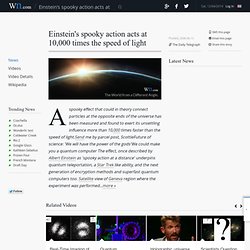

Quantum entanglement. Quantum entanglement is a physical phenomenon that occurs when pairs or groups of particles are generated or interact in ways such that the quantum state of each particle cannot be described independently – instead, a quantum state may be given for the system as a whole.

Such phenomena were the subject of a 1935 paper by Albert Einstein, Boris Podolsky and Nathan Rosen,[1] describing what came to be known as the EPR paradox, and several papers by Erwin Schrödinger shortly thereafter.[2][3] Einstein and others considered such behavior to be impossible, as it violated the local realist view of causality (Einstein referred to it as "spooky action at a distance"),[4] and argued that the accepted formulation of quantum mechanics must therefore be incomplete.
History[edit] However, they did not coin the word entanglement, nor did they generalize the special properties of the state they considered. Concept[edit] Quantum entanglement, conciousness and event horizons. Einstein's spooky action acts at 10,000 times the speed of light. A bonus scene from REALITY LOST, a different documentary about quantum mechanics by Karol Jalochowski, the movie produced by Centre for Quantum Technologies (CQT) at National University of Singapore.

Christian Kurtsiefer, a Principal Investigator at CQT, explains how and why he hacks quantum cryptographic systems. Dag Kaszlikowski is the host. We filmed this conversation at the Thow Kwang Pottery Jungle.